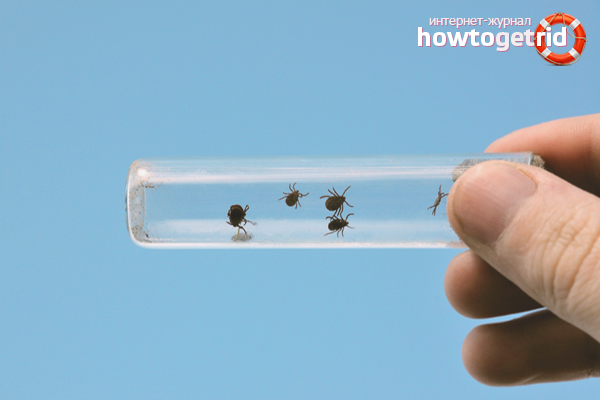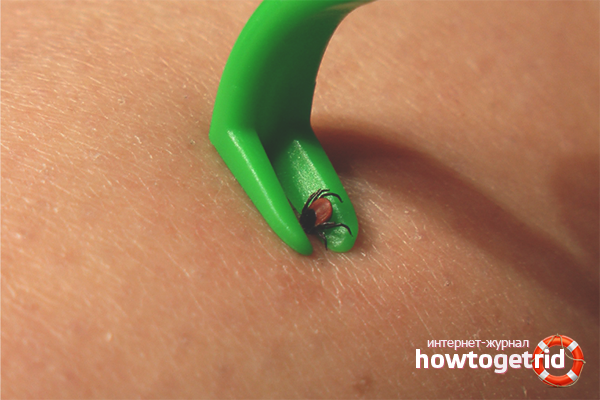The content of the article
With the arrival of warm days, few of the townspeople are in no hurry to nature. Parks, forests, gardens and groves - these are favorite places that each of us loves to visit. However, outdoor recreation brings not only joy, satisfaction and fun. Picnics are often clouded by unpleasant insects - ticks.
A tick is one of the oldest insects, which has more than forty thousand subspecies. Most ticks feed on tiny organisms, fungal spores, and plant foods. Only a few species of these insects drink the blood of animals and people.
Ticks live in forested areas; they live in grass and shrubs. Most often ticks are located along the paths that people and pets walk on. The insect feels the approach of a person due to its incredibly sensitive sense of smell. If you are from a tick at a distance of 8-10 meters, he already knows about your approach. The tick is conveniently located at the ends of the blades of grass and, when touched, snaps tightly onto your clothing.
The tick does not bite a person right away, for a start he needs to choose a suitable place for this. Most often, tick bites occur on the scalp, neck, shoulders, internal bends of the knees and elbows - that is, places with thin skin. The tick slowly rises to the head along the leg and, choosing a suitable place, firmly sticks to your skin. His proboscis looks like the thinnest bolt that is screwed into the skin, getting to tidbits. A person does not feel a bite, because anesthetics are present in the saliva of the tick. The body of the bloodsucker is flat and small, but after a meal the tick inflates and increases significantly in size. When an insect drinks blood, it itself falls off the skin. However, in most cases, a person discovers a bloodsucker even before he is full.
What are dangerous tick bites
In addition to encephalitis, a person after a tick bite can become infected with monocytic ehrlichiosis, Lyme disease. All these diseases are extremely dangerous and in the absence of timely medical care can be fatal. Along with this, each person can individually respond to an insect bite. An allergic reaction may occur with vomiting, rash, and fever. That is why it is so important to immediately consult a doctor after a tick bite. And if possible, bring the insect to the laboratory for research.
How to pull a tick yourself
Of course, the doctor will best cope with this task. However, most often ticks stick to a person in nature when there are no medical facilities nearby. In this case, you need to be able to provide medical care in a timely and competent manner. So, how to get a tick in a person at home?
Thread
Sometimes in traveling conditions there is no tweezers or clamp at hand. Then an ordinary thread will do. Make a small loop and throw it on the tick. Tighten the loop so that it is at the very base of the proboscis of the insect.After that, carefully pull out the bloodsucker in a circular motion. Do not pull so that the proboscis does not remain under the skin!
Arms
If the situation requires a quick solution, you can pull out the tick with your hands, or rather, with your nails. Gently grab the insect closer to the proboscis and twist, as in the previous methods of extracting the bloodsucker with tweezers or thread. Be careful not to squeeze the tick with your fingers. Otherwise, it can inject even more poison into the skin.
Syringe
This is another way to safely remove the tick. For its implementation, we need a regular medical syringe without a needle. At the syringe, you need to cut off the upper part, where the needle is attached. The cut should be as even as possible, so as to fit more tightly to the body. Carefully put the cap on the insect, and then pull the piston back. A vacuum will appear inside the syringe, which will remove the bloodsucker.
Tweezers
When you pull out a tick, it is important to remember that you need to do this carefully and accurately, so that its proboscis completely goes outside, and does not come off and does not remain in the skin. This is best done with a medical clamp. It has sharp edges that can be used to grip the insect tightly. Instead of clamping, you can use simple tweezers, which can be found in every woman’s cosmetic bag even in traveling conditions. Hold the tick tightly, but not tightly, otherwise you can just crush it. Grab the bloodsucker closer to the proboscis. It is not necessary to pull it out, the screwed trunk can simply come off. Carefully scroll the insect around its axis to remove it along with the proboscis.
To date, the pharmacy has special devices in the form of curved tweezers. They are designed to safely remove ticks. If you are going on a camping trip or camping, do not forget to put this necessary thing in a first-aid kit.
After extraction
Remember that the whole procedure should be as safe as possible for you. Before removing the tick with improvised means, it is necessary to disinfect all devices that will come in contact with an open wound.
After extraction, you need to disinfect the wound. To do this, treat it with iodine, potassium permanganate, hydrogen peroxide, alcohol or other antiseptics. If during extraction part of the tick (its head or proboscis) remained inside the skin, additional measures should be taken. To do this, take a disinfected needle and carefully remove the foreign body from the skin, like a splinter. Treat the wound and consult a doctor in order to exclude the possibility of infection with serious diseases that the tick suffers.
The insect itself can be burned, drowned or delivered for research. To do this, he is placed in a jar with a small amount of water so that the bloodsucker survives to the laboratory.
Is it possible to fill the tick with oil
There is an opinion that in order to fish out a tick, it needs to be poured with vegetable oil. At the same time, he suffocates and releases the skin himself. Indeed, a tick cannot be without air for a long time, and he does not like this procedure. However, doctors do not recommend using this method of extracting an insect.
The fact is that when a tick gets drunk with vegetable oil, it can simply burp it. And since its proboscis is in your skin, oil along with poison is injected into your bloodstream. This is extremely dangerous. Also, do not use ammonia and other compounds to remove the tick.
How to protect yourself from tick bites
Before you sit on the grass, be sure to lay a coverlet. For a picnic, use special sprays, ointments and lotions that will help you scare away ticks and other annoying insects.
And further. Before the summer season, it would be nice to be vaccinated against encephalitis. It will help you protect yourself from a probable tick-borne illness.
Forewarned is forearmed. The knowledge of where ticks live, how dangerous they are and how to get them out of human skin is priceless. Follow all safety precautions, act correctly and quickly to protect yourself and your children from tick bites.
Video: how to pull out a tick











Submit